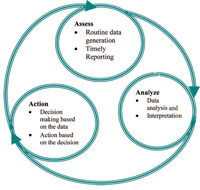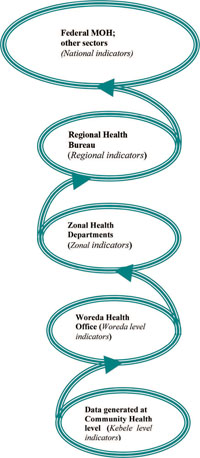13.5 The triple A cycle approach
The NIS should be a continuous (cyclic) process which is undertaken regularly using the principle of the triple A cycle used in CBN, which you learned about in Study Session 11 of this Module. Information generated by the NIS can be use for decision making from your local community level to the national level. As you will remember from Study Session 11, the triple A cycle has:
- An assessment aspect involving service generated data recording and timely reporting
- Analysis and interpretation of the data based on the national guidelines and procedure
- An action component which involves decision making and implementation using the information, which in turn will automatically be followed by another assessment.
This is illustrated in Figure 13.4, which shows how each element of the cycle is connected to the other.
The data you record as part of routine programmes is a critical element of nutrition intervention programmes and therefore needs to be recorded accurately and reported in a timely way. Figure 13.5 illustrates how data collection informs decision making through the different level, right up to the Federal Ministry of Health.
13.6 Conclusion
In this Module you’ve learned about the basics: food, diet and nutrients, and the different nutritional requirements throughout the human lifecycle. You have looked at nutritional problems of public health importance in Ethiopia and the role you can play as a Health Extension Practitioner in identifying and recording nutrition problems in your community and how can you advise and support the individuals you work with to find effective nutrition solutions. As you’ve learned, the nutrition information you generate at the kebele level can be used to monitor nutrition indicators and to inform decision making at different levels.
13.4.1 Sources of data for the NIS


